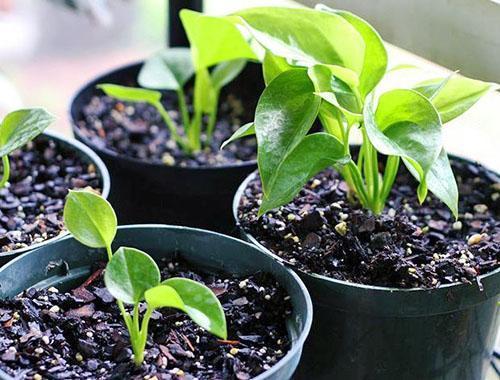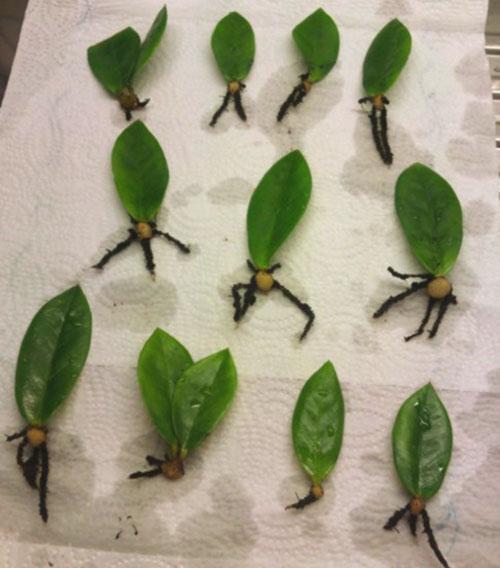New Anthurium flower can be grown from seeds
 Anthuriums, the indigenous inhabitants of tropical forests, attract the attention of indoor plant lovers with their bright foliage, and unusual aerial roots, so necessary for the life of an epiphyte, and impressive inflorescences of a variety of colors. These plants today, more than ever, are popular all over the world, so the issue of reproduction of a beautiful indoor anthurium flower is of interest to both beginners and experienced gardeners.
Anthuriums, the indigenous inhabitants of tropical forests, attract the attention of indoor plant lovers with their bright foliage, and unusual aerial roots, so necessary for the life of an epiphyte, and impressive inflorescences of a variety of colors. These plants today, more than ever, are popular all over the world, so the issue of reproduction of a beautiful indoor anthurium flower is of interest to both beginners and experienced gardeners.
It is not difficult to propagate the variety you like. Most often, vegetative methods are used for these purposes, which is explained by a decent rooting rate, the availability of planting material and the insignificant complexity of the process.
When transplanting, an adult anthurium bush can be easily divided into several parts, and also from time to time the formed basal shoots with their own root system can be separated from it.
Such children of anthurium, as well as the stem layers or cuttings used for reproduction, fully retain their parental properties. Therefore, even the owners of rare hybrids do not have to worry that the beauty of inflorescences or foliage will be lost.

Reproduction of anthurium leaf
Like other representatives Aroid family, this culture is extremely difficult and reluctant to form roots on leaf stalks.
 Reproduction of anthurium by a leaf in the overwhelming majority of cases fails. Unlike zamiokulkas, which forms small nodules at the base of the leaf and children with their own root system, anthurium rots, and the leaf dies.
Reproduction of anthurium by a leaf in the overwhelming majority of cases fails. Unlike zamiokulkas, which forms small nodules at the base of the leaf and children with their own root system, anthurium rots, and the leaf dies.
If there are decorative leafy species of anthurium in the florist's collection, you can try using the leaves to get young rosettes. True, in this case, it is better not to immerse the petioles in water, but to carefully dig in the leaf plates into wet perlite.
In warm air and maintaining constant humidity after 3-4 weeks, the plant sometimes forms roots and are suitable for further growing anthurium children.
How to grow anthurium from seeds?
 With all the advantages of vegetative reproduction, these methods do not provide an opportunity to obtain mass seedlings. An adult anthurium bush when dividing can give no more than 5–6 young plants, a little more seedlings are obtained by cuttings.
With all the advantages of vegetative reproduction, these methods do not provide an opportunity to obtain mass seedlings. An adult anthurium bush when dividing can give no more than 5–6 young plants, a little more seedlings are obtained by cuttings.
Seed propagation is the only way available at home to grow several dozen small anthuriums at the same time.
However, the use of this method is associated with a number of difficulties and risks. So, for example, hybrid plants, which represent the majority in the modern flower market, do not always retain recognizable traits and properties. In addition, when planning to grow anthurium from seeds, the florist should know that the flowers will have to be pollinated artificially.
If you look at the anthurium inflorescence, you will notice that the ear consists of tiny bisexual flowers that bloom gradually from below, in the direction of the peduncle. First, the pistils ripen, and only after 20–25 days does pollen appear, that is, the male stage of flowering begins.
In nature, fragrant anthurium flowers attract a lot of pollination insects, transferring pollen from one inflorescence to another.
 But at home, the owner of the plant will have to take on this role.To do this, you need to stock up on a thin soft brush, choose a sunny day and, taking pollen from one inflorescence, pollinate another ear with it. To increase the likelihood of fruit production, the inflorescences need to be pollinated within 5–8 days.
But at home, the owner of the plant will have to take on this role.To do this, you need to stock up on a thin soft brush, choose a sunny day and, taking pollen from one inflorescence, pollinate another ear with it. To increase the likelihood of fruit production, the inflorescences need to be pollinated within 5–8 days.
 Depending on the cultivated species, anthurium in place of one inflorescence can tie from two to several dozen berries. Ripening lasts 8–12 months, while ripe fruits have different shapes, colors and sizes. You can find out that the anthurium berry has ripened by the fact that it has become noticeably more convex and poured. Sometimes juicy berries practically hang from the cob, holding on to a thin threadlike stalk.
Depending on the cultivated species, anthurium in place of one inflorescence can tie from two to several dozen berries. Ripening lasts 8–12 months, while ripe fruits have different shapes, colors and sizes. You can find out that the anthurium berry has ripened by the fact that it has become noticeably more convex and poured. Sometimes juicy berries practically hang from the cob, holding on to a thin threadlike stalk.
 The number of seeds inside the fruit also fluctuates. As you can see in the photo, anthurium seeds are not very large, and since their germination rate decreases extremely quickly, it will not work to save the seed for future use.
The number of seeds inside the fruit also fluctuates. As you can see in the photo, anthurium seeds are not very large, and since their germination rate decreases extremely quickly, it will not work to save the seed for future use.
To prepare seeds for planting:
- ripe fruits are kneaded;
- the seed is removed from the pulp and washed;
- the grains are treated with a 0.1% solution of potassium permanganate.
 This measure is necessary, since anthurium seeds are not quickly dried before sowing, and they are threatened with decay and mold formation.
This measure is necessary, since anthurium seeds are not quickly dried before sowing, and they are threatened with decay and mold formation.
Like adult anthurium plants, seeds need a loose, moisture and air permeable environment for growing.
It is best to sow in flat containers with a small layer:
- light structured soil mixed with perlite or vermiculite;
- perlite or sphagnum moss.
Seeds are laid out on a damp surface, easily pressing into the substrate, but not sprinkled. The container with crops should be covered with a lid, glass or foil, after which it is left at a temperature of 22 to 25 ° C.
 After 1.5–2 weeks, the first shoots can be expected to appear, and their quality and speed of formation largely depends on the degree of maturity of the collected seeds and the conditions created for growth. Before growing anthurium from seeds, the grower will have to accumulate patience and know in advance that this is the longest and most laborious way of plant propagation.
After 1.5–2 weeks, the first shoots can be expected to appear, and their quality and speed of formation largely depends on the degree of maturity of the collected seeds and the conditions created for growth. Before growing anthurium from seeds, the grower will have to accumulate patience and know in advance that this is the longest and most laborious way of plant propagation.
Seedlings can be dived after the opening of the first true leaf, and tiny plants are transplanted into new containers with a soil mixture similar to the "adult" soil, but only with smaller fractions. As the rosettes of anthurium grown from seeds develop, it is regularly transplanted, gradually increasing the distance between the plants.
 Anthurium can be transferred to separate pots with a volume of 100-200 ml when the rosette reaches 5-7 cm.
Anthurium can be transferred to separate pots with a volume of 100-200 ml when the rosette reaches 5-7 cm.
As in the case of adult plants, the seedlings are transferred into a new container when the root system has fully mastered the volume assigned to it. If you initially plant anthurium in spacious containers, the plant develops more slowly, and the risk of soil acidification due to waterlogging also sharply increases.
At home, anthuriums from seeds enter the flowering time no earlier than one and a half or two years.
Despite the large number of plants obtained by seed propagation, their flowering does not always fully satisfy the needs of the grower. This is because most of the blooming anthurium varieties sold today are hybrids.
 The offspring of such plants, obtained from anthurium seeds, can be strikingly different from the parental specimens. This applies not only to the size of the rosette and the height of the plant. Most often, indoor plant lovers are disappointed that anthurium flowers do not resemble the previous generation either in appearance or in the color of the bracts.
The offspring of such plants, obtained from anthurium seeds, can be strikingly different from the parental specimens. This applies not only to the size of the rosette and the height of the plant. Most often, indoor plant lovers are disappointed that anthurium flowers do not resemble the previous generation either in appearance or in the color of the bracts.
Therefore, seed propagation is suitable only for varietal plants, and it is better to propagate hybrids with an affordable vegetative method.